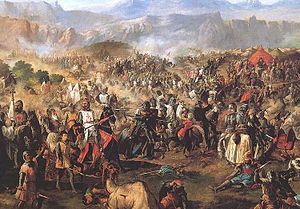Battle of Navas de Tolosa
| Battle of Las Navas de Tolosa | |||||||
|---|---|---|---|---|---|---|---|
| Part of the Reconquista | |||||||
 A 19th century portrayal of the battle by Francisco de Paula Van Halen |
|||||||
|
|||||||
| Belligerents | |||||||
|
|
|
||||||
| Commanders and leaders | |||||||
|
|
|
||||||
| Strength | |||||||
| 12,000–14,000 | ~22,000–30,000 | ||||||
| Casualties and losses | |||||||
| unknown | very high | ||||||
The Battle of Las Navas de Tolosa, known in Arab history as the Battle of Al-Uqab (معركة العقاب), took place on 16 July 1212 and was an important turning point in the Reconquista and in the medieval history of Spain. The Christian forces of King Alfonso VIII of Castile were joined by the armies of his rivals, Sancho VII of Navarre, Peter II of Aragon and Afonso II of Portugal, in battle against the Berber Almohad Muslim rulers of the southern half of the Iberian Peninsula. The Caliph al-Nasir (Miramamolín in the Spanish chronicles) led the Almohad army, made up of people from the whole Almohad empire. Most of the men in the Almohad army came from the African side of the empire.
In 1195, Alfonso VIII of Castile was defeated by the Almohads in the so-called Disaster of Alarcos. After this victory the Almohads took several important cities: Trujillo, Plasencia, Talavera, Cuenca, and Uclés. Then, in 1211, Muhammad al-Nasir crossed the Strait of Gibraltar with a powerful army, invaded Christian territory, and captured Salvatierra Castle, the stronghold of the knights of the Order of Calatrava. The threat to the Hispanic Christian kingdoms was so great that Pope Innocent III called European knights to a crusade.
...
Wikipedia
